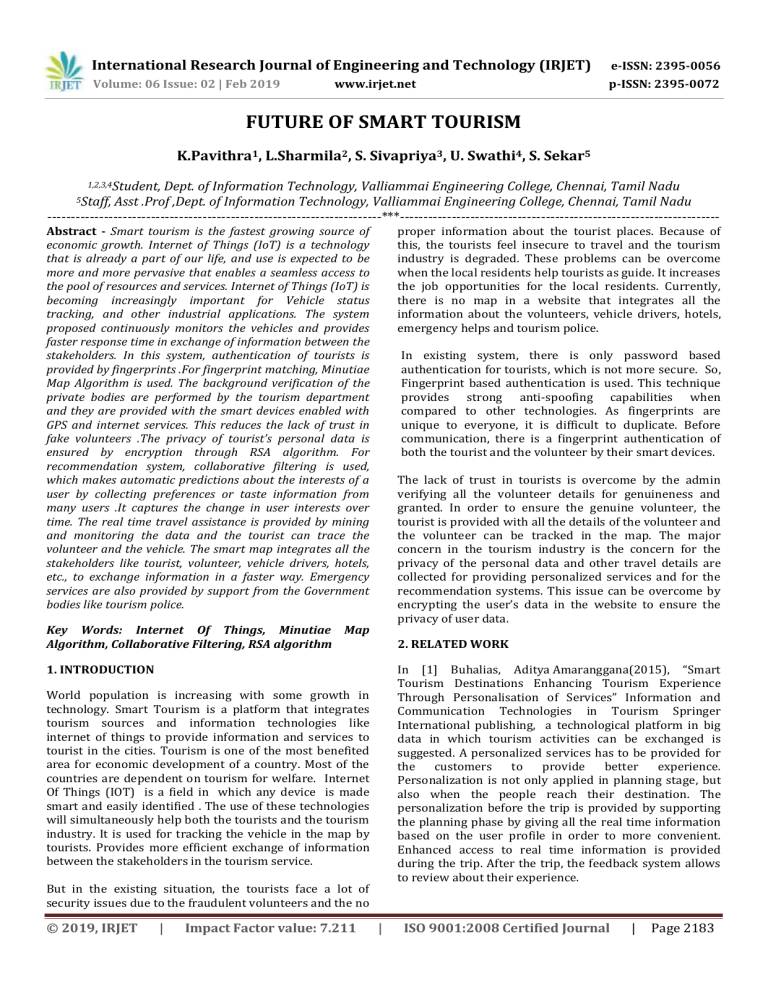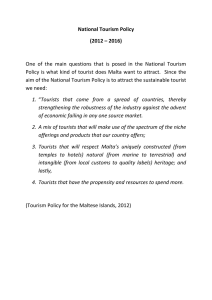IRJET- Future of Smart Tourism
advertisement

International Research Journal of Engineering and Technology (IRJET) e-ISSN: 2395-0056 Volume: 06 Issue: 02 | Feb 2019 p-ISSN: 2395-0072 www.irjet.net FUTURE OF SMART TOURISM K.Pavithra1, L.Sharmila2, S. Sivapriya3, U. Swathi4, S. Sekar5 1,2,3,4Student, Dept. of Information Technology, Valliammai Engineering College, Chennai, Tamil Nadu Asst .Prof ,Dept. of Information Technology, Valliammai Engineering College, Chennai, Tamil Nadu -----------------------------------------------------------------------***-------------------------------------------------------------------5Staff, Abstract - Smart tourism is the fastest growing source of economic growth. Internet of Things (IoT) is a technology that is already a part of our life, and use is expected to be more and more pervasive that enables a seamless access to the pool of resources and services. Internet of Things (IoT) is becoming increasingly important for Vehicle status tracking, and other industrial applications. The system proposed continuously monitors the vehicles and provides faster response time in exchange of information between the stakeholders. In this system, authentication of tourists is provided by fingerprints .For fingerprint matching, Minutiae Map Algorithm is used. The background verification of the private bodies are performed by the tourism department and they are provided with the smart devices enabled with GPS and internet services. This reduces the lack of trust in fake volunteers .The privacy of tourist’s personal data is ensured by encryption through RSA algorithm. For recommendation system, collaborative filtering is used, which makes automatic predictions about the interests of a user by collecting preferences or taste information from many users .It captures the change in user interests over time. The real time travel assistance is provided by mining and monitoring the data and the tourist can trace the volunteer and the vehicle. The smart map integrates all the stakeholders like tourist, volunteer, vehicle drivers, hotels, etc., to exchange information in a faster way. Emergency services are also provided by support from the Government bodies like tourism police. proper information about the tourist places. Because of this, the tourists feel insecure to travel and the tourism industry is degraded. These problems can be overcome when the local residents help tourists as guide. It increases the job opportunities for the local residents. Currently, there is no map in a website that integrates all the information about the volunteers, vehicle drivers, hotels, emergency helps and tourism police. In existing system, there is only password based authentication for tourists, which is not more secure. So, Fingerprint based authentication is used. This technique provides strong anti-spoofing capabilities when compared to other technologies. As fingerprints are unique to everyone, it is difficult to duplicate. Before communication, there is a fingerprint authentication of both the tourist and the volunteer by their smart devices. The lack of trust in tourists is overcome by the admin verifying all the volunteer details for genuineness and granted. In order to ensure the genuine volunteer, the tourist is provided with all the details of the volunteer and the volunteer can be tracked in the map. The major concern in the tourism industry is the concern for the privacy of the personal data and other travel details are collected for providing personalized services and for the recommendation systems. This issue can be overcome by encrypting the user’s data in the website to ensure the privacy of user data. Key Words: Internet Of Things, Minutiae Map Algorithm, Collaborative Filtering, RSA algorithm 2. RELATED WORK In [1] Buhalias, Aditya Amaranggana(2015), “Smart Tourism Destinations Enhancing Tourism Experience Through Personalisation of Services” Information and Communication Technologies in Tourism Springer International publishing, a technological platform in big data in which tourism activities can be exchanged is suggested. A personalized services has to be provided for the customers to provide better experience. Personalization is not only applied in planning stage, but also when the people reach their destination. The personalization before the trip is provided by supporting the planning phase by giving all the real time information based on the user profile in order to more convenient. Enhanced access to real time information is provided during the trip. After the trip, the feedback system allows to review about their experience. 1. INTRODUCTION World population is increasing with some growth in technology. Smart Tourism is a platform that integrates tourism sources and information technologies like internet of things to provide information and services to tourist in the cities. Tourism is one of the most benefited area for economic development of a country. Most of the countries are dependent on tourism for welfare. Internet Of Things (IOT) is a field in which any device is made smart and easily identified . The use of these technologies will simultaneously help both the tourists and the tourism industry. It is used for tracking the vehicle in the map by tourists. Provides more efficient exchange of information between the stakeholders in the tourism service. But in the existing situation, the tourists face a lot of security issues due to the fraudulent volunteers and the no © 2019, IRJET | Impact Factor value: 7.211 | ISO 9001:2008 Certified Journal | Page 2183 International Research Journal of Engineering and Technology (IRJET) e-ISSN: 2395-0056 Volume: 06 Issue: 02 | Feb 2019 p-ISSN: 2395-0072 www.irjet.net In [2] Shuhui Jiang , Xueming Qian ,Tao Mei , Yun Fu (2016), “Personalized Travel Sequence Recommendation on Multi-Source Big Social Media”, IEEE Transactions on Big Data , the personalization is done not only based on user’s travel interest, but also recommends a travel sequence rather than Points Of Interests(POIs). The photos are filtered from each city from all the users and geo-location restriction is also applied because community contributed photos will have lot of noises. So the POIs will have both GPS coordinates and travelogues description, which guarantees route package mining, the famous routes are ranked according to the user package and the route package. The most ranked routes are then further optimized by social similar user’s travel records. In this work, the system automatically mines user’s and route’s travel topical preferences based on cost, time, and, season. This system only focused on POI travel sequence recommendation, not on transportation and hotel information. based filtering, which requires, negative samples in order to know the negative preference. The scalable content aware collaborative filtering (ICCF) was proposed will provided a clear negative sampling. It not only works well for location recommendation but also works well during the cold start cases. The experiment showed that the ICCF is superior to other methods including state of art location recommendation algorithm. The effects of user profiles and semantic content has shown that, they improve recommendation in warm start cases and help address cold start cases. 3. PROPOSED SYSTEM We have proposed a system in which the tourist will have the fingerprint based authentication to ensure it is a legitimate user. The fingerprint matching is done with the help of Minutiae Map algorithm. It provides more anti spoofing capabilities compared to passwords. The stakeholders are undergone a background verification by the tourism department officials and will be registered. Before communication, both the side there will the fingerprint authentication. The volunteers and the other stakeholders are provided with the smart phones enabled with the GPS, internet services, so that the tourist can trace them in the map. Each human involved in tourism service are provided a Smart Device. The smart devices are uniquely identified by the means of identification. It also has the authentication by the help of fingerprint sensors. In [3] Ruizhi Wu , Guangchun Luo ,Qinli Yang , Junming Shao (2017) , “Learning Individual Moving Preference and Social Interaction for Location Prediction”, IEEE Access, proposed a new location prediction model taking both the individual preferences and social interactions (PSI) at a group level to alleviate the effect of randomness and improve the location prediction performance. The PSI provides an efficient way to model human movement from two aspects, one is individual’s moving preferences and exterior social interactions. It provides a better predication performance compared to other state of the art methods. The main highlight is that exterior social interactions are modelled using only the sketching group patterns. A smart map has been proposed in which all the stakeholders are connected. The human resources like tourists, tourism police, volunteers and the vehicle drivers and hotels are integrated in the map to exchange information between them. In the volunteer map, he can view the details of for the tourist, after receiving the request. In the vehicle map, the driver will update the starting and ending point, and the location of the vehicle is automatically updated. In [4] Andrea Zanella , Lorenzo Vangelista (2017) , “Internet of Things for Smart Cities” , IEEE Internet Of Things Journal , aims at exploiting the most advanced communication technologies to support the citizens by providing the value added services. It mainly focuses on providing urban IOT. The urban IOT provides a distributed database of information collected from the various sensors placed at many locations. The backend servers are located in the control center in which the data are collected, stored and processed for providing value added services. The IOT nodes are RF tags, which play a more important role in monitoring and other services. IOT enables these objects to be connected and exchange data between them. The smart will show the availability of the Points of interests (POI), which will help the tourists to choose the right POI during travel. The overcomes the uncertain travelling time between the POIs. The emergency services are provided like police, ambulances by support from government bodies. The recommendation system usually extracts user’s data in order to provide personal recommendation .We have proposed a privacy protected recommendation system, in which all the user’s data will be encrypted using RSA algorithm. In [5] Defu Lian ,Yong Ge ; Fuzheng Zhang ,Nicholas Jing Yuan ,Xing Xie ,Tao Zhou , Yong Rui (2017) , “Scalable Content-Aware Collaborative Filtering for Location Recommendation”, IEEE Transactions Knowledge and Data Engineering, focuses on location recommendation which will be helpful for the tourists to find many places. Usually in other methods, there was a cold start problem in which the system will not be able to recommend the new users. The typical method uses explicit feedback © 2019, IRJET | Impact Factor value: 7.211 | ISO 9001:2008 Certified Journal | Page 2184 International Research Journal of Engineering and Technology (IRJET) e-ISSN: 2395-0056 Volume: 06 Issue: 02 | Feb 2019 p-ISSN: 2395-0072 www.irjet.net Fig -1: Architecture Diagram 4. METHODOLOGY In our proposed system, ideal thinned ridge is considered. We assume usually a thinned ridge will have a value 1 or 0. The algorithm uses 3*3 windows to scan the image and the bifurcation and termination in the final output image shall be represented by a dot. Let’s consider (x,y) denote the pixel on the thinned ridge and N0, n1, ……N7 denote its neighbours. 4.1 Minutiae Map Algorithm Fingerprint based biometric authentication is an important and widely used biometric type authentication because of its cost, accuracy and feasibility. In our proposed system, the user fingerprint feature are extracted and verified using Minutiae Map algorithm (MM). A pixel (x,y) is a ridge ending if, Minutiae Map algorithm identifies the fingerprint ridges and extracts the bifurcation and termination values from the input fingerprint image. Ridge termination is the point at which fingerprint ridge ends. Bifurcation is the point at which ridge splits into two halves which is shown in the below figure. Our proposed system provides the respective user fingerprint total bifurcation, termination values along with its location (X, Y coordinates) and stores in the database during user registration. A pixel (x,y) is a ridge bifurcation if, On successful authentication, tourists personal details, passport details and emergency details would be projected. It’s not mandatory for the tourists to carry his / her passport and other original proofs. 4.2 RSA Algorithm The RSA Algorithm is used to encrypt the user’s details. It is an asymmetric cryptographic algorithm. It uses two types of keys namely public and the private key. This is known as public key cryptography. Because one key is visible to everyone and the other key is kept private. Fig -2: Fingerprint bifurcation and termination © 2019, IRJET | Impact Factor value: 7.211 | ISO 9001:2008 Certified Journal | Page 2185 International Research Journal of Engineering and Technology (IRJET) e-ISSN: 2395-0056 Volume: 06 Issue: 02 | Feb 2019 p-ISSN: 2395-0072 www.irjet.net The idea is more secure because large integers are difficult to factorize.. The public key consists of two numbers .One number is multiplication of two large prime numbers. And private key is also derived from those two prime numbers. So if somebody can factorize the large number, the private key is found out. REFERENCES Hence, strength of the algorithm totally lies on the key size and if we double or triple the key size, the strength of encryption increases exponentially. RSA keys can be 1024 or 2048 bits long. [1] Buhalias ,Aditya Amaranggana (2015) , “ Smart Tourism Destinations Enhancing Tourism Experience Through Personalisation of Services” Information and Communication Technologies in Tourism Springer International publishing [2] Shuhui Jiang , Xueming Qian ,Tao Mei , Yun Fu (2016), “Personalized Travel Sequence Recommendation on Multi-Source Big Social Media”, IEEE Transactions on Big Data [3] Ruizhi Wu , Guangchun Luo ,Qinli Yang , Junming Shao (2017) , “Learning Individual Moving Preference and Social Interaction for Location Prediction”, IEEE Access [4] Andrea Zanella , Lorenzo Vangelista (2017) , “Internet of Things for Smart Cities” , IEEE Internet Of Things Journal [5] Defu Lian ,Yong Ge ; Fuzheng Zhang ,Nicholas Jing Yuan ,Xing Xie ,Tao Zhou , Yong Rui (2017) , “Scalable Content-Aware Collaborative Filtering for Location Recommendation” , IEEE Transactions Knowledge and Data Engineering. [6] Abdul Majid , Ling Chen, Gencai Chen , Hamid Turab Mirza , Ibrar Hussain ,John Woodward(2013) ,” A context aware personalised travel recommendation system based on geotagged social media data mining” International Journal of Geographical Information Science. [7] Chenyi Zhang, Hongwei Liang_, Ke Wang_, Jianling Sun ,”Personalized Trip Recommendation with POI Availability and Uncertain Traveling Time”. Fig -3: RSA algorithm process CONCLUSION As travelling is one of the important aspect today, it is very important that proper planning need to be done beforehand in terms of time management. Most people without using the latest technologies waste a lot of time in planning trips. This system provides a fingerprint based authentication for the tourists and the volunteers. The fraudulent volunteers are avoided and only the legitimate people can escort the tourist. The tourist can trace the volunteers and vehicle in the smart map. All the stakeholders are interconnected in the smart map to exchange information with a faster response time. Emergency services are provided by support from the government bodies. The privacy of user’s personal data is ensured by means of encryption. FUTURE ENHANCEMENT The smart tourism and the recommendation is long way to go. The future work will focus on improving the existing system in order to provide most efficiently performing system. Though the research in the development of recommendation system is growing largely in now a days, a major issue comes into existence as how to implement recommendation techniques in real world and how to solve the problem of large and dynamic input datasets. An algorithm that works well offline on small datasets may become inefficient when tested online with large datasets. © 2019, IRJET | Impact Factor value: 7.211 | ISO 9001:2008 Certified Journal | Page 2186




